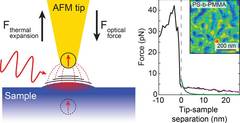Photoinduced tip-sample forces for chemical nanoimaging and spectroscopy
| Reviews and Highlights | Quantum Science | Molecular and Soft-matter | Ultrafast Nano-optics and Nanophotonics | Mineralogy and Geochemistry |
|---|
Brian T. O’Callahan, Jun Yan, Fabian Menges, Eric A. Muller, and Markus B. Raschke
Nano Lett. 18, 5499 (2018).
DOI PDF SI

Control of photoinduced forces allows nanoparticle manipulation, atom trapping, and fundamental studies of light-matter interactions. Scanning probe microscopy enables the local detection of photoinduced effects with nano-optical imaging and spectroscopy modalities being used for chemical analysis and the study of physical effects. Recently, the development of a novel scanning probe technique has been reported with local chemical sensitivity attributed to the localization and detection of the optical gradient force between a probe tip and sample surface via infrared vibrationally resonant coupling. However, the magnitude and spectral line shape of the observed signals disagree with theoretical predictions of optical gradient forces. Here, we clarify this controversy by resolving and analyzing the interplay of several photoinduced effects between scanning probe tips and infrared resonant materials through spectral and spatial force measurements. Force spectra obtained on IR-active vibrational modes of polymer thin films are symmetric and match the material absorption spectra in contrast to the dispersive spectral line shape expected for the optical gradient force response. Sample thickness dependence shows continuous increase in force signal beyond the thickness where the optical dipole force would saturate. Our results illustrate that photoinduced force interactions between scanning probe tips and infrared-resonant materials are dominated by short-range thermal expansion and possibly long-range thermally induced photoacoustic effects. At the same time, we provide a guideline to detect and discriminate optical gradient forces from other photoinduced effects, which opens a new perspective for the development of new scanning probe modalities exploiting ultrastrong opto-mechanical coupling effects in tip?sample cavities.
